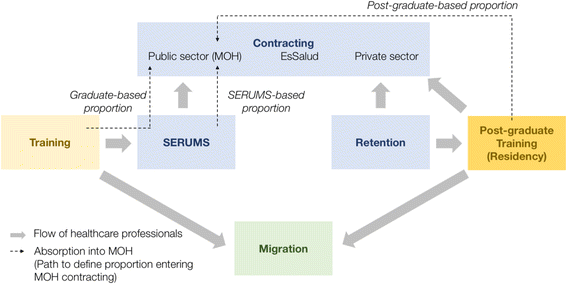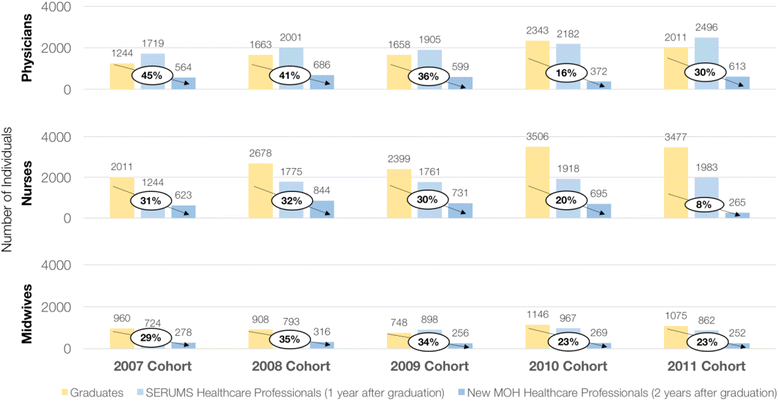Human resources for health in Peru: recent trends (2007-2013) in the labour market for physicians, nurses and midwives
- PMID: 28934979
- PMCID: PMC5609041
- DOI: 10.1186/s12960-017-0243-y
Human resources for health in Peru: recent trends (2007-2013) in the labour market for physicians, nurses and midwives
Abstract
Background: Most analyses of gaps in human resources for health (HRH) do not consider training and the transition of graduates into the labour market. This study aims to explore the labour market for Peru's recent medical, nursing, and midwifery graduates as well as their transition into employment in the Ministry of Health's (MOH) system.
Methods: Data from four different datasets, covering 2007-2013, was used to characterize the patterns of recently trained physicians, nurses, midwives, and postgraduate-trained physicians that enter employment in the MOH system, and scenario analyses were used to describe how this rate of entry needs to adapt in order to fill current HRH shortages.
Results: HRH graduates have been increasing from 2007 to 2011, but the proportions that enter employment in the MOH system 2 years later range from 8 to 45% and less than 10% of newly trained medical specialists. Scenario analyses indicate that the gap for physicians and nurses will be met in 2027 and 2024, respectively, while midwives in 2017. However, if the number of HRH graduates entering the MOH system doubles, these gaps could be filled as early as 2020 for physicians and 2019 for nurses. In this latter scenario, the MOH system would still only utilize 56% of newly qualified physicians, 74% of nurses, and 66% of midwives available in the labour market.
Conclusion: At 2013 training rates, Peru has the number of physicians, nurses, and midwives it needs to address HRH shortages and meet estimated HRH gaps in the national MOH system during the next decade. However, a significant number of newly qualified health professionals do not work for the MOH system within 2 years of graduation. These analyses highlight the importance of building adequate incentive structures to improve the entry and retention of HRH into the public sector.
Keywords: Human resources for health; Labour market; Peru.
Conflict of interest statement
Ethics approval and consent to participate
This study used anonymized datasets and thus did not require ethics approval.
Consent for publication
Not applicable.
Competing interests
The authors declare that they have no competing interests.
Publisher’s Note
Springer Nature remains neutral with regard to jurisdictional claims in published maps and institutional affiliations.
Figures


Similar articles
-
Retention of qualified healthcare workers in rural Senegal: lessons learned from a qualitative study.Rural Remote Health. 2017 Jul-Sep;17(3):4149. doi: 10.22605/RRH4149. Epub 2017 Sep 12. Rural Remote Health. 2017. PMID: 28899101
-
[Demand for training and availability of health science professionals in Peru].Rev Peru Med Exp Salud Publica. 2015 Jan-Mar;32(1):41-50. Rev Peru Med Exp Salud Publica. 2015. PMID: 26102104 Spanish.
-
Medical doctors profile in Ethiopia: production, attrition and retention. In memory of 100-years Ethiopian modern medicine & the new Ethiopian millennium.Ethiop Med J. 2008 Jan;46 Suppl 1:1-77. Ethiop Med J. 2008. PMID: 18709707
-
A meta-ethnographic synthesis of midwives' and nurses' experiences of adverse labour and birth events.J Clin Nurs. 2017 Dec;26(23-24):4184-4200. doi: 10.1111/jocn.13965. Epub 2017 Sep 19. J Clin Nurs. 2017. PMID: 28722761 Review.
-
Perspective: Leveraging the health care workforce: what do we need and what educational system will get us there?Acad Med. 2011 Nov;86(11):1448-53. doi: 10.1097/ACM.0b013e318230588b. Acad Med. 2011. PMID: 21952060 Review.
Cited by
-
Favorable Attitudes Toward Research in Nursing Students During Internship: A Cross-Sectional Study in Peru.SAGE Open Nurs. 2023 Oct 19;9:23779608231206776. doi: 10.1177/23779608231206776. eCollection 2023 Jan-Dec. SAGE Open Nurs. 2023. PMID: 37868113 Free PMC article.
-
Current State of Diabetes Mellitus Prevalence, Awareness, Treatment, and Control in Latin America: Challenges and Innovative Solutions to Improve Health Outcomes Across the Continent.Curr Diab Rep. 2020 Oct 10;20(11):62. doi: 10.1007/s11892-020-01341-9. Curr Diab Rep. 2020. PMID: 33037442 Free PMC article. Review.
-
Lessons Learnt during the Implementation of WISN for Comprehensive Primary Health Care in India, South Africa and Peru.Int J Environ Res Public Health. 2021 Nov 28;18(23):12541. doi: 10.3390/ijerph182312541. Int J Environ Res Public Health. 2021. PMID: 34886270 Free PMC article.
-
Health care provider time in public primary care facilities in Lima, Peru: a cross-sectional time motion study.BMC Health Serv Res. 2021 Feb 6;21(1):123. doi: 10.1186/s12913-021-06117-9. BMC Health Serv Res. 2021. PMID: 33549079 Free PMC article.
-
A descriptive analysis of health practices, barriers to healthcare and the unmet need for cervical cancer screening in the Lower Napo River region of the Peruvian Amazon.Womens Health (Lond). 2019 Jan-Dec;15:1745506519890969. doi: 10.1177/1745506519890969. Womens Health (Lond). 2019. PMID: 31840562 Free PMC article.
References
-
- World Health Organization (WHO). Achieving the health-related MDGs. It takes a workforce! http://www.who.int/hrh/workforce_mdgs/en/ (accessed 23/09/2016).
MeSH terms
Grants and funding
LinkOut - more resources
Full Text Sources
Other Literature Sources
Medical
Miscellaneous

